SEO
What Is IMC? Integrated Marketing Communications Explained
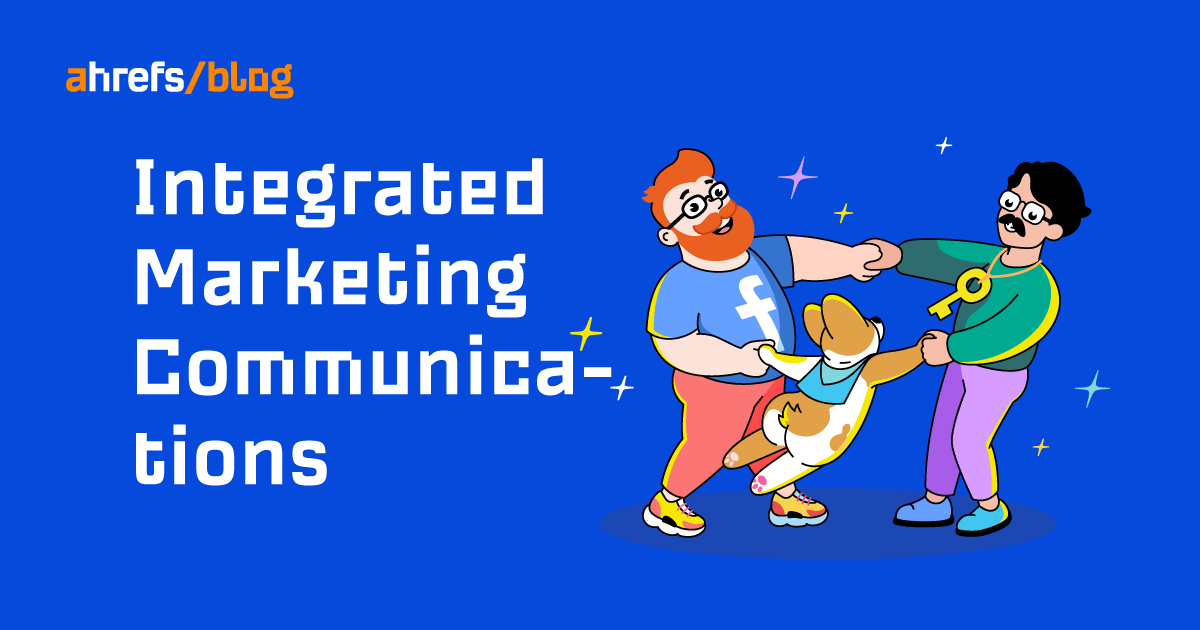
Integrated marketing communications is a requirement for long-term marketing success. The effectiveness of all your marketing campaigns largely depends on it.
One can easily get lost in what it entails, though. Some universities even offer degrees in marketing communications. On top of that, there are now more media and marketing channels than ever before.
But don’t worry, we’ll only focus on the most important aspects of integrated marketing communications. In this article, we’ll go through the following:
Let’s start with a proper definition.
Integrated marketing communications (IMC) is the process of unifying a brand’s messaging to make it consistent across all media that the brand uses to reach its target audience. It’s a strategic approach that guides communication and tactics used across all marketing channels.
Every organization uses multiple channels to communicate with its audiences. We’ve come a long way from having a relatively small number of “traditional” channels like TV, radio, newspapers, out-of-home advertising, and mailboxes. In today’s digital world, it can get difficult to keep track of all the media you can reach your potential customers with.
Focusing on multiple marketing channels at once is a necessity for many companies. This omnichannel marketing requires a strategic approach to make it all work together toward achieving marketing objectives. This is when IMC comes into play.
There are four main reasons why IMC is important:
- Need for consistency throughout the whole customer journey
- IMC helps with brand-building
- Properly using right mix of marketing channels helps boost campaign effectiveness
- IMC contributes to marketing channels reinforcing each other
Let’s expand on each point a bit more. Some of the research findings included may even change the way you look at marketing.
1. Need for consistency throughout the whole customer journey
The next time you buy something, think about when you first heard of the brand of the product, the product itself, and how you arrived at the decision to make the purchase.
Besides commodities, chances are that you’ll not buy a product the first time you see it. You usually go through a whole buying journey that may be done from start to finish on the same day (clothes) but can also span several years (cars):

This is related to the marketing funnel. It’s a model that depicts how people become customers—from first learning about the brand to making the purchase:

In principle, increasing your customer base is straightforward: get as many people to the top of the funnel as possible and minimize the leaks between stages of the funnel. The way you achieve that is, of course, much more complicated (otherwise we marketers wouldn’t have jobs).
But one thing is certain.
Communicating in a consistent and recognizable way across all your marketing channels creates a smooth customer journey throughout the whole marketing funnel.
You ideally want to build on the product and brand associations you create in the Awareness stage and guide the potential customers further down the funnel. This is what IMC largely contributes to.
Take Wise, for example. No matter when and how you encounter its communications, that will always revolve around the company promising the best exchange rates and no hidden fees for its money transfer and exchange services. This is all accompanied by blue, its brand color.
Here’s an excerpt from one of its top-of-the-funnel organic search landing pages:

Then we have an example of its PR campaign:
https://www.youtube.com/watch?v=mKOAZkuP6_E
And lastly, here are a few of its most visited PPC search ads that people can encounter further down the funnel in the U.K.:
Sidenote.
Consistency is one of the four Cs of IMC introduced by David Pickton and Amanda Broderick in 2001 in their book, “Integrated Marketing Communications.” The other Cs stand for coherence, complementary, and continuity.
I’m covering the four Cs of the IMC model here in this article, but I refuse to refer to them as such. That’s because there’s already a more famous four Cs marketing model that refers to the marketing mix. Just be aware of the ambiguity of the four Cs.
2. IMC helps with brand-building
Let me expand on some of the previously mentioned points. Communicating in a consistent and recognizable way is a big part of brand-building. You want people to join the dots between all your campaigns to build and strengthen the set of associations they have with your brand.
It should now be obvious that you should strive to deliver the right message at the right time. But the key to brand-building lies in accompanying all your communications with brand codes to increase distinctiveness.
A brand code, or distinctive asset, is anything that you consistently use in your communications. See how this intertwines with IMC? Codifying your communications should be part of integrating it. That way, you can better link together all your campaigns, maintain salience, and bolster your brand image.
The most common brand code is a logo. Every company has one. The logo alone doesn’t cut it, though. Most companies also have certain visual styles, but that’s about it. You should strive to have three to five brand codes in total.
At Ahrefs, besides our logo and the color blue, we also have two more brand codes. The first is our custom font:

The second is our bearded guy mascot, who’s often accompanied by a corgi. You may have noticed them in the header image of this article:
If not, here they are again:

One last point is regarding brand codes and IMC. When you start to think that you’re pushing the codes into your communications too much, codify even more. As marketers, we perceive this differently from the target audience. What’s overwhelming for us may just be the threshold for people consistently noticing the codes.
3. Properly using right mix of marketing channels helps boost campaign effectiveness
IMC makes you rethink what marketing channels you’re on and how you use them. There are now myriads of ways to reach people online and offline. But let’s face it: Unless you’re selling products to the mass market, you should be rather picky with your choices. You can’t likely do much with an industrial B2B product on TikTok, and it is hard to integrate that with the rest of your communication channels.
On the other hand, you should strive to have a great presence on all the relevant channels and media. Research suggests the more media channels in the mix, the more effective the campaign is likely to be. I know. It’s easier said than done, given the limited resources in every company.
Speaking of resources…
Generally, the most ideal approach to integrating your communications is to spend 60% of your budget on the brand-building part and the remaining 40% on uplifting sales. This is based on one of the most insightful and valuable marketing researches of the past two decades:

Your marketing channels mix should reflect the approximate 60:40 ratio. Some are more suitable for brand-building (TV, billboards, YouTube ads), while others are better for sales activation (search ads, remarketing ads). There will be overlaps in the purpose of many channels too, so don’t worry about trying to be accurate here.
4. IMC contributes to marketing channels reinforcing each other
When you do communication right, marketing channels have the ability to make each other more powerful as your company grows. This concept of “marketing flywheel” was popularized by Rand Fishkin, and the best way to explain it in detail is to show you one of the flywheel diagrams:

As long as your marketing channels are properly integrated, you can rely on this flywheel effect. Ahrefs is proof of that. The main marketing driver behind our growth is the long-term, compounding effect of word-of-mouth marketing combined with SEO and content marketing.
Enough theory. Let’s take a look at three specific examples of well-integrated marketing communications in practice.
Patagonia – Reflecting what it stands for
There are not many companies like Patagonia, a brand that reflects core values in its communications and actions.
Patagonia constantly succeeds in making the point that it cares about the planet and sustainability. This was its Black Friday ad, for example:

It sometimes goes way beyond anyone’s expectations, such as cutting off one of its main marketing channels for good:
Patagonia stopped all paid advertising on Facebook platforms in June 2020 because they spread hate speech and misinformation about climate change and our democracy. We continue to stand by that boycott 16 months later.
— Patagonia (@patagonia) October 28, 2021
This directly affects its business and goes against the practice of utilizing as many suitable marketing channels as possible. But this may be balanced by the reinforcing of its brand image and it staying true to the company values.
If that’s not enough, the company even gets political at times. Patagonia sued former President Donald Trump’s administration to support its environmental causes with this:

I don’t know how this activism affected sales, but one thing is clear: Patagonia is consistent and believable in what it stands for. You can’t say that about many other companies promoting a “higher good.” Just recall some controversial Pepsi or Gillette ads.
Sephora – Masterclass in codifying communications
Remember the part about codifying what you put out into the world to the point where it seems exceedingly overwhelming to you? Sephora does a great job at maximizing the exposure of its distinctive assets.
First of all, it has a carefully selected palette of brand codes:
Sephora utilizes its name, the curved “S” logo (some people refer to it as “flame”), black and white stripes, and the color red as a contrasting element. These are simple yet effective when you look at the brand’s communications.
Here’s one of its sales activation FB ads running at the time of me writing this article:

Basically, when the target audience sees a cosmetic ad that’s black and white with some red elements, Sephora is most likely what comes to mind for most of them—and they may not even need to check the ad’s details.
But I think Sephora’s real-life presence is even better (from a communications and branding perspective). Its store design is a branding masterpiece:
Then you can see its customers walking around with this:
Yes, even a simple paper bag can be a tool that you can integrate with your communication strategy.
To wrap this up, here’s a good celebration and summary of its brand codes usage in a rather unusual ad format:
https://www.youtube.com/watch?v=j0WuHSaSa1s
Ahrefs – Everything revolves around the product
It would be hypocritical to sell you the idea of implementing IMC if we didn’t adhere to its principles ourselves. So here’s an example based on our own approach to marketing and communications.
Ahrefs is a product-led B2B SaaS company. We didn’t have a single dedicated marketing team member in the first four years of our existence. We still don’t have a sales team despite being a $100M+ ARR company. The value of our SEO product is the main driver behind our growth.
We now have solid marketing operations in place, but the focus is still on the product. We don’t shy away from communicating this focus on our product even in somewhat unusual ways:

Nevertheless, the most important part of our communications is product-led content. Browse through our blog, watch our YouTube videos, and check out our social media posts. You’ll encounter countless ways of our product naturally being part of the conversation:

Talking about SEO and showing Ahrefs’ interface as a natural part of discussing multiple ways to reduce customer acquisition cost.
This YouTube comment on one of our videos perfectly sums up what we’re going for:

We even have our own private community (made up of our customers) that gets to learn about all the news first:

But rest assured. This information then gets shared on all the other distribution channels mentioned earlier.
Final thoughts
If I have to summarize the essence of IMC and its best practices, I’ll do so with these four points:
- Be consistent with the message you send out to the world
- Make all your marketing channels work together in the long term
- The more channels you use, the better—as long as you can find your audience there
- Split your marketing budget into approximately 60% brand-building and 40% short-term sales-boosting
Basically, if you have a good marketing strategy based on solid market research, you’ll be great at IMC without even knowing you do IMC.
Got any questions? Ping me on Twitter.
SEO
Measuring Content Impact Across The Customer Journey
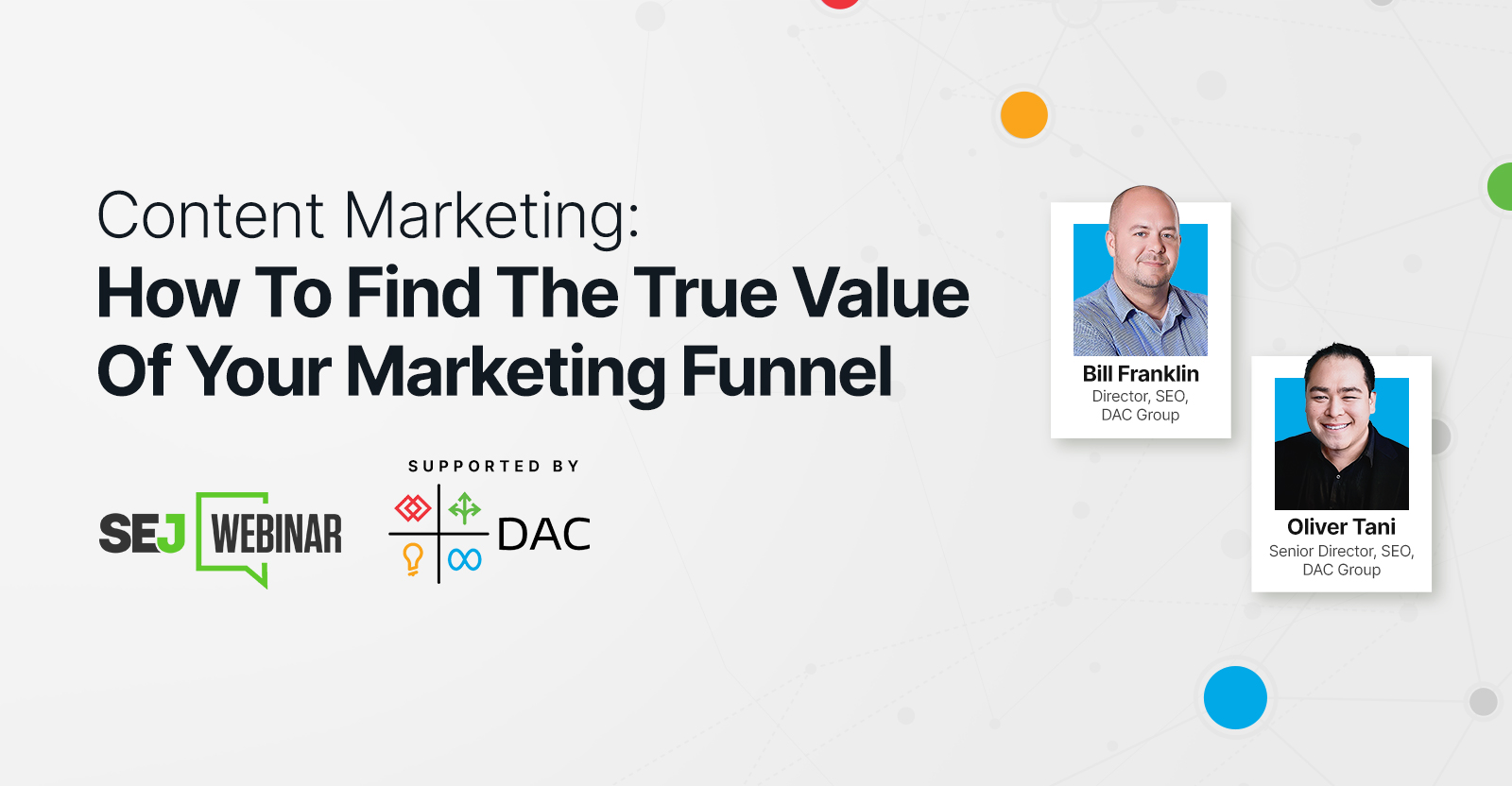
Understanding the impact of your content at every touchpoint of the customer journey is essential – but that’s easier said than done. From attracting potential leads to nurturing them into loyal customers, there are many touchpoints to look into.
So how do you identify and take advantage of these opportunities for growth?
Watch this on-demand webinar and learn a comprehensive approach for measuring the value of your content initiatives, so you can optimize resource allocation for maximum impact.
You’ll learn:
- Fresh methods for measuring your content’s impact.
- Fascinating insights using first-touch attribution, and how it differs from the usual last-touch perspective.
- Ways to persuade decision-makers to invest in more content by showcasing its value convincingly.
With Bill Franklin and Oliver Tani of DAC Group, we unravel the nuances of attribution modeling, emphasizing the significance of layering first-touch and last-touch attribution within your measurement strategy.
Check out these insights to help you craft compelling content tailored to each stage, using an approach rooted in first-hand experience to ensure your content resonates.
Whether you’re a seasoned marketer or new to content measurement, this webinar promises valuable insights and actionable tactics to elevate your SEO game and optimize your content initiatives for success.
View the slides below or check out the full webinar for all the details.
SEO
How to Find and Use Competitor Keywords

Competitor keywords are the keywords your rivals rank for in Google’s search results. They may rank organically or pay for Google Ads to rank in the paid results.
Knowing your competitors’ keywords is the easiest form of keyword research. If your competitors rank for or target particular keywords, it might be worth it for you to target them, too.
There is no way to see your competitors’ keywords without a tool like Ahrefs, which has a database of keywords and the sites that rank for them. As far as we know, Ahrefs has the biggest database of these keywords.
How to find all the keywords your competitor ranks for
- Go to Ahrefs’ Site Explorer
- Enter your competitor’s domain
- Go to the Organic keywords report
The report is sorted by traffic to show you the keywords sending your competitor the most visits. For example, Mailchimp gets most of its organic traffic from the keyword “mailchimp.”


Since you’re unlikely to rank for your competitor’s brand, you might want to exclude branded keywords from the report. You can do this by adding a Keyword > Doesn’t contain filter. In this example, we’ll filter out keywords containing “mailchimp” or any potential misspellings:
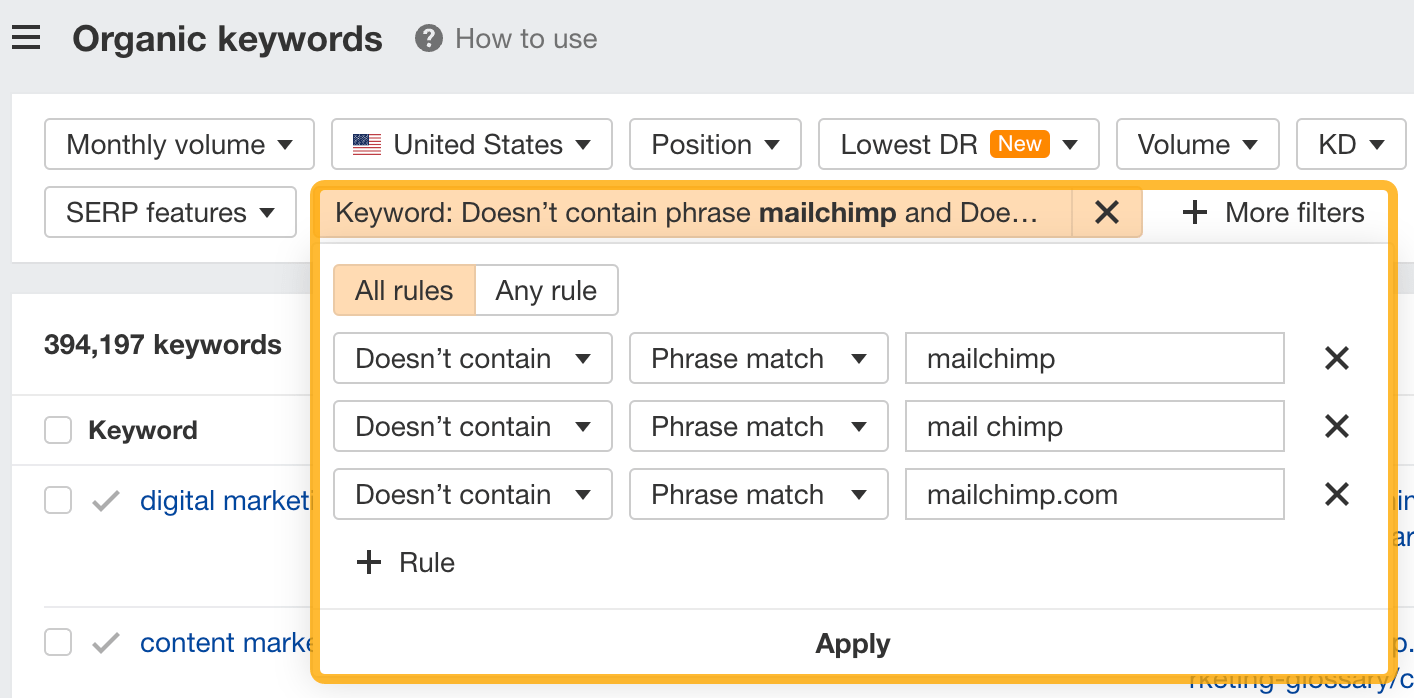

If you’re a new brand competing with one that’s established, you might also want to look for popular low-difficulty keywords. You can do this by setting the Volume filter to a minimum of 500 and the KD filter to a maximum of 10.
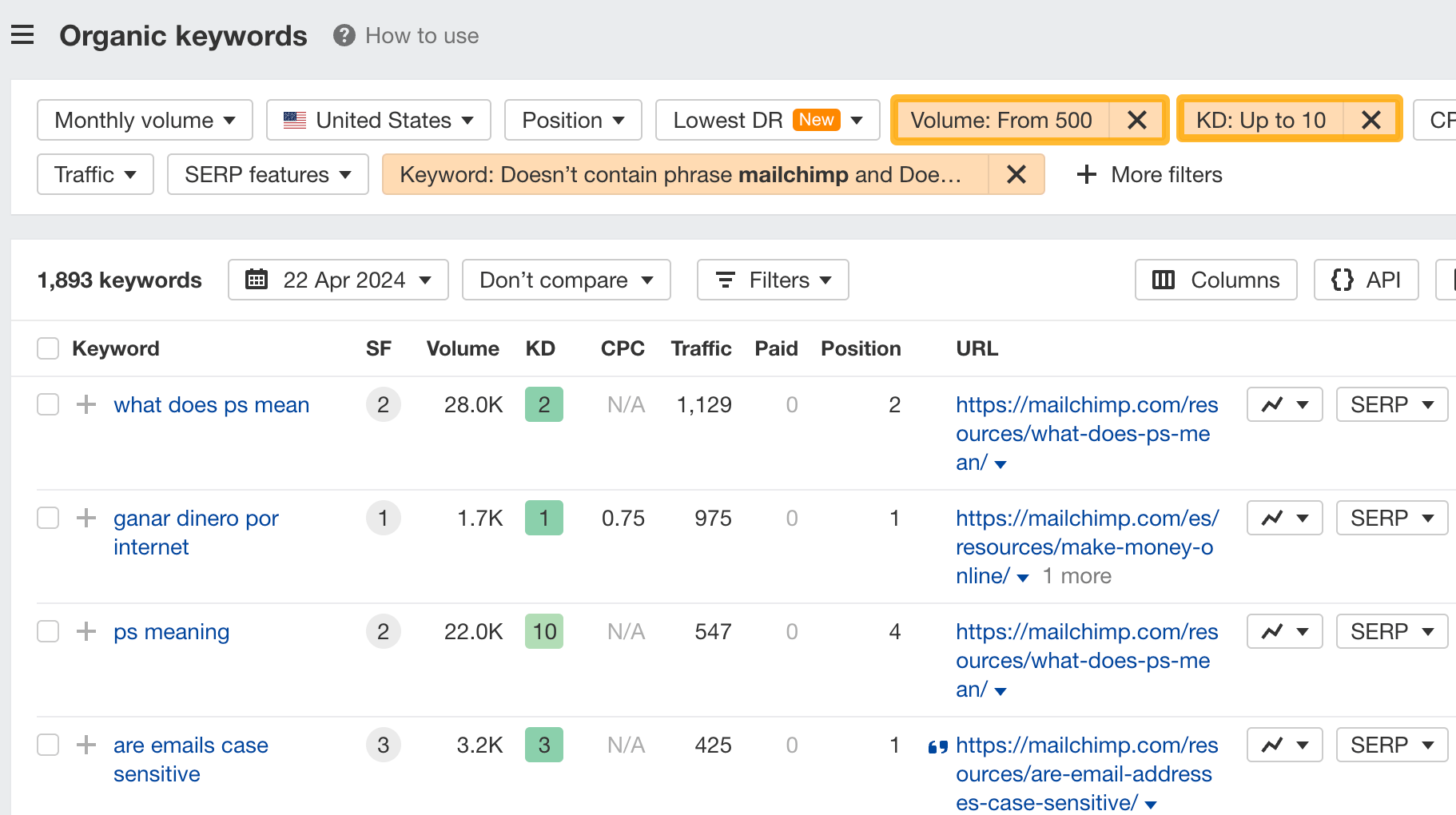

How to find keywords your competitor ranks for, but you don’t
- Go to Competitive Analysis
- Enter your domain in the This target doesn’t rank for section
- Enter your competitor’s domain in the But these competitors do section
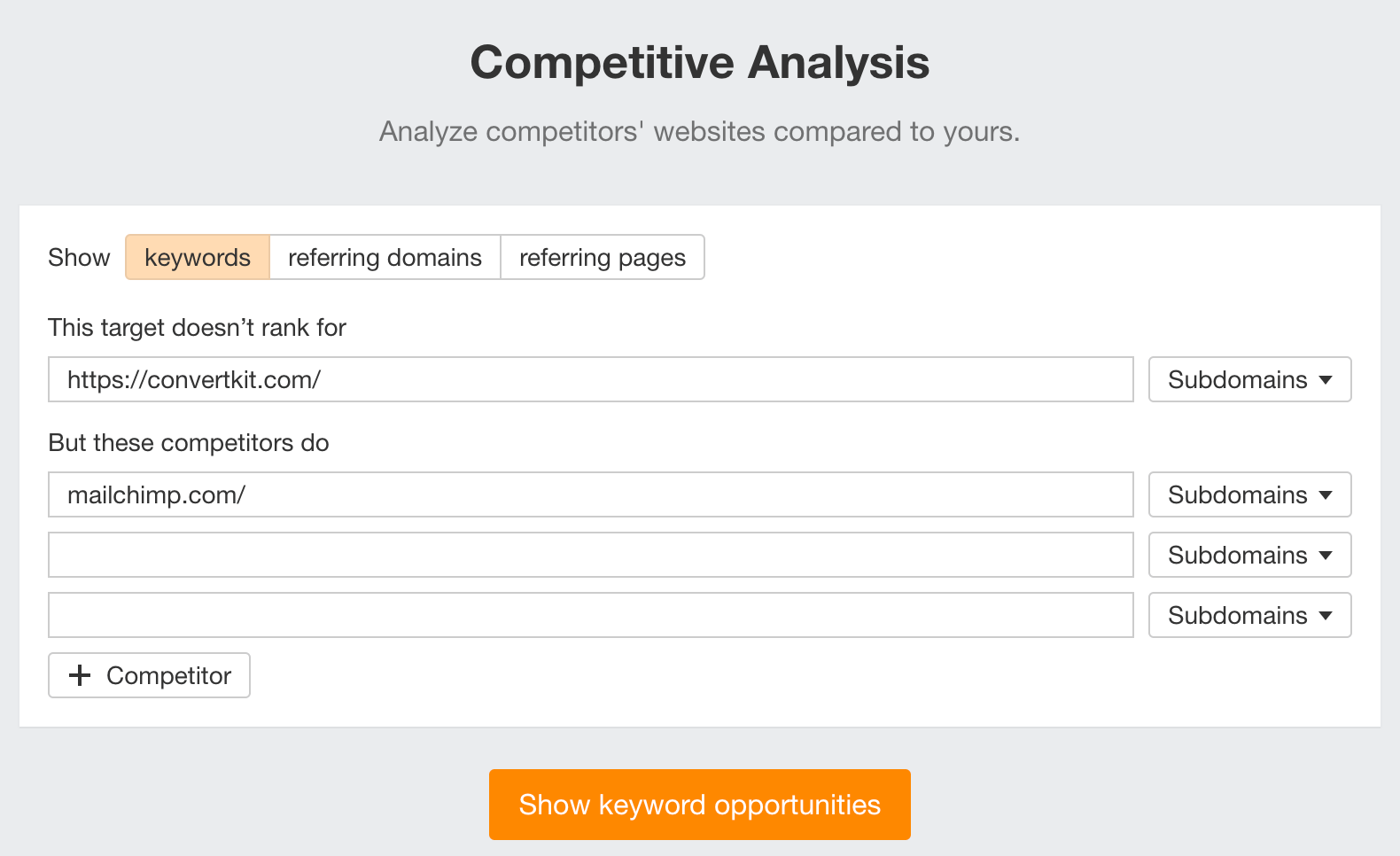

Hit “Show keyword opportunities,” and you’ll see all the keywords your competitor ranks for, but you don’t.
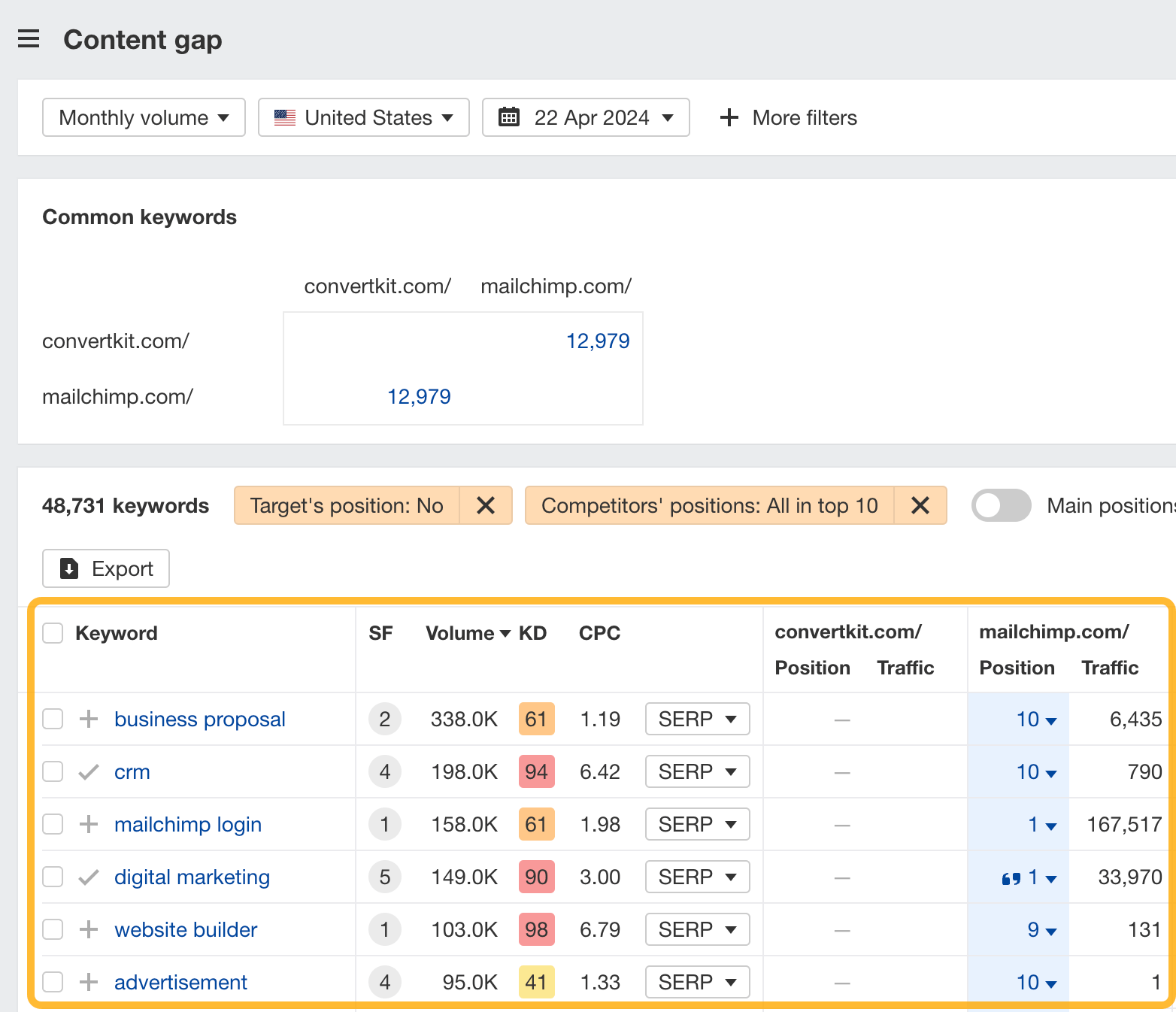

You can also add a Volume and KD filter to find popular, low-difficulty keywords in this report.
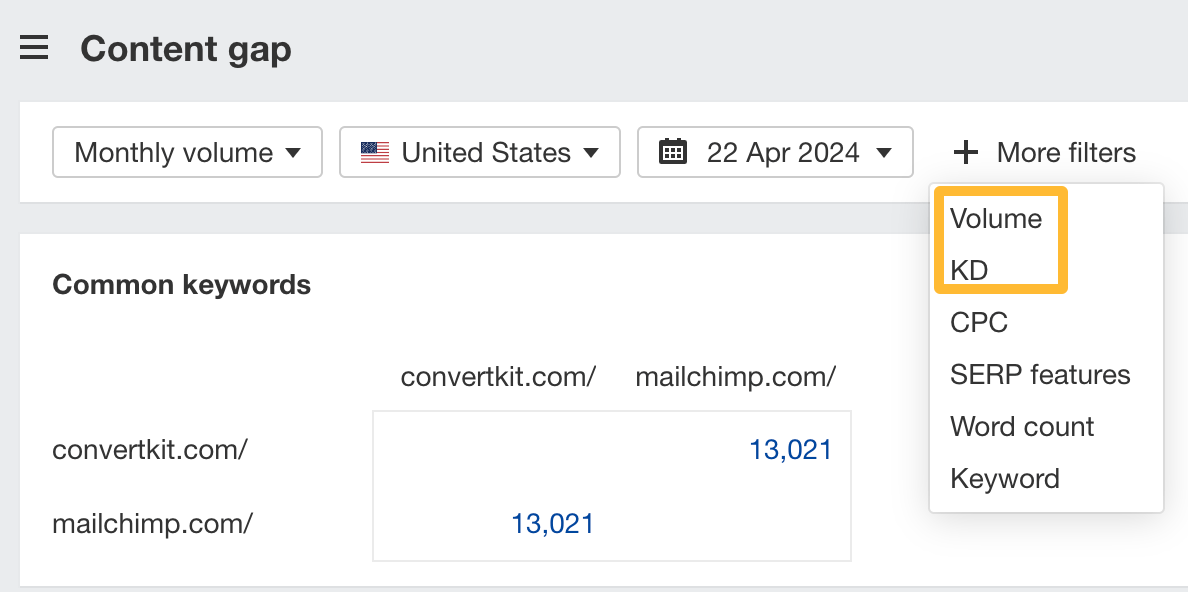

How to find keywords multiple competitors rank for, but you don’t
- Go to Competitive Analysis
- Enter your domain in the This target doesn’t rank for section
- Enter the domains of multiple competitors in the But these competitors do section
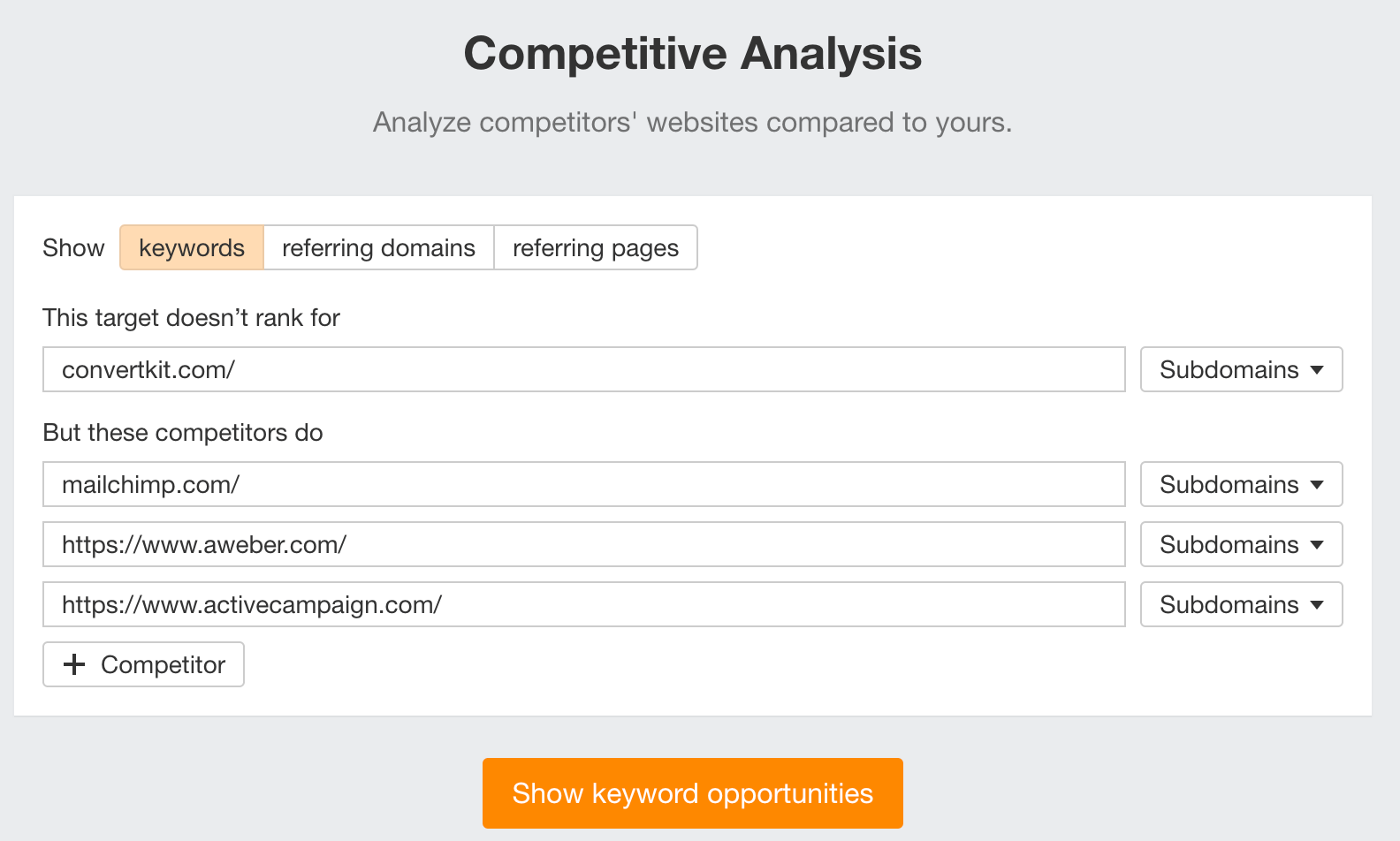

You’ll see all the keywords that at least one of these competitors ranks for, but you don’t.
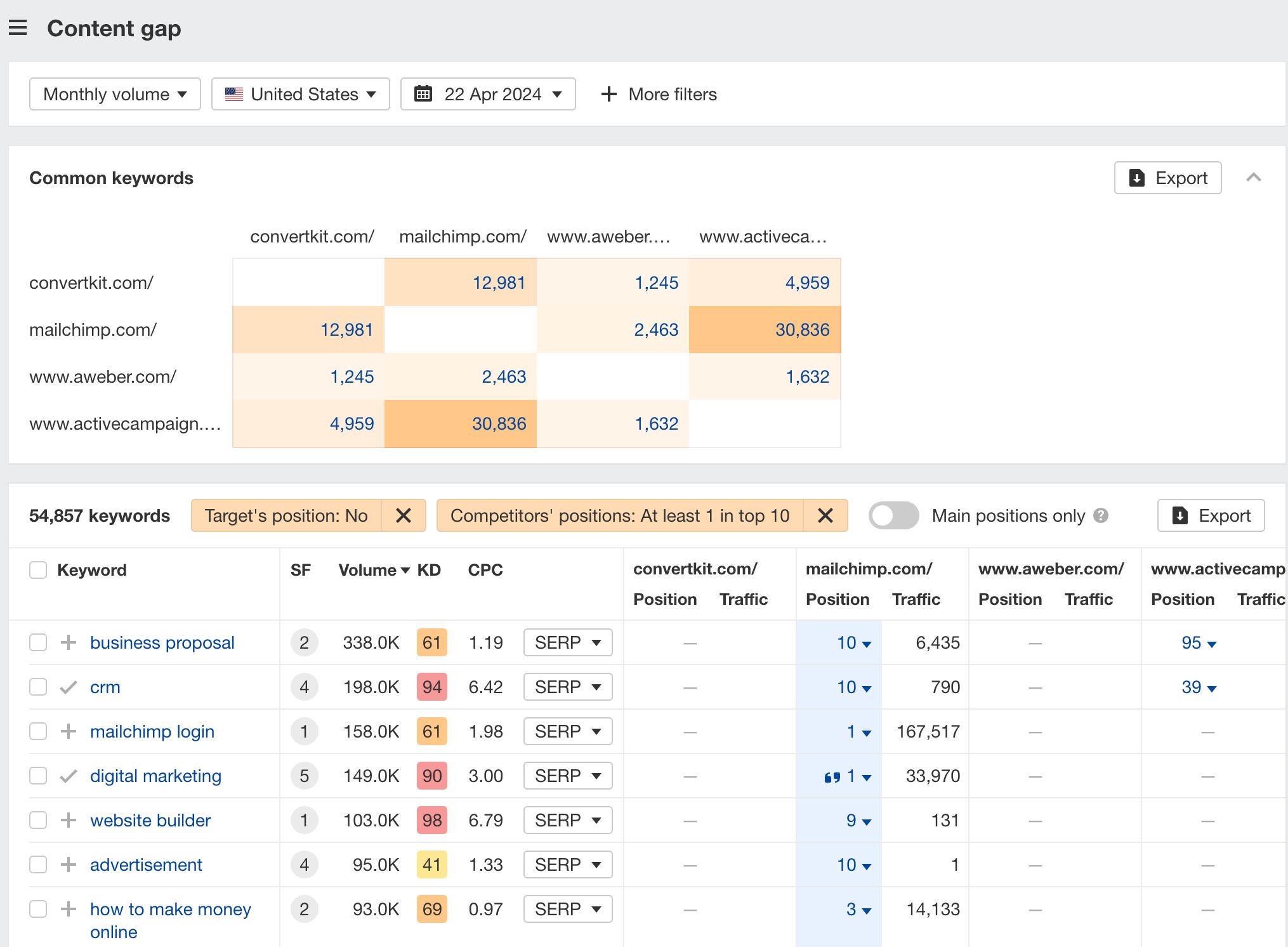

You can also narrow the list down to keywords that all competitors rank for. Click on the Competitors’ positions filter and choose All 3 competitors:
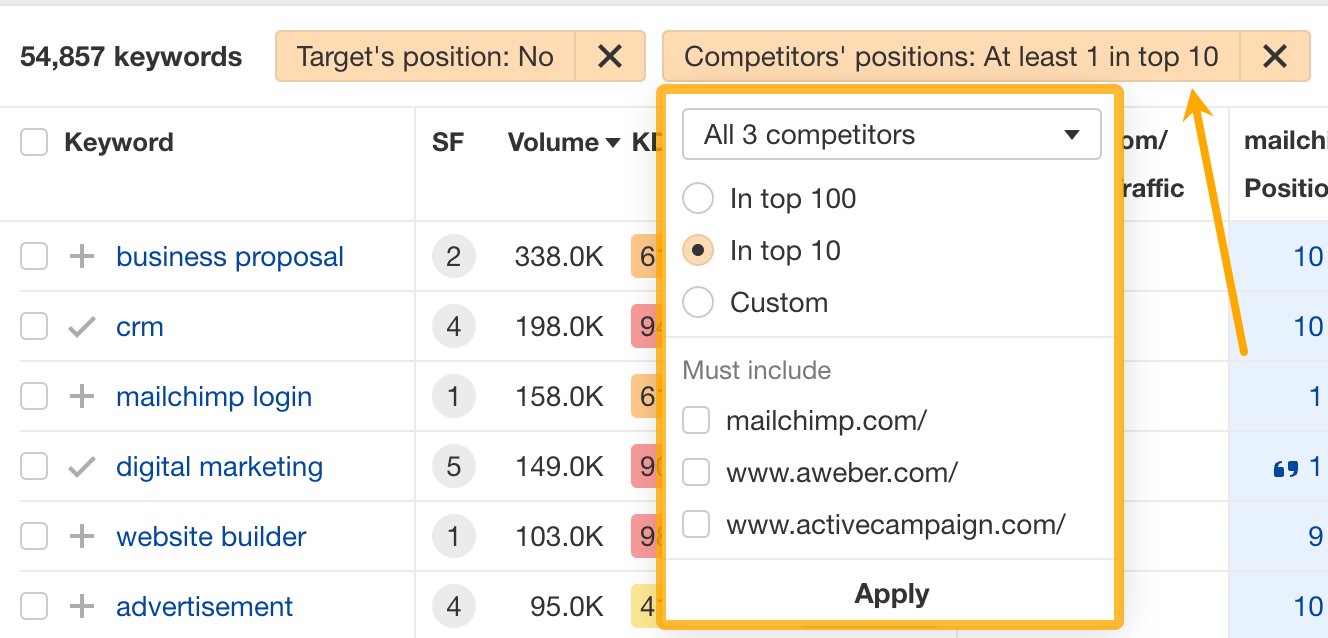

- Go to Ahrefs’ Site Explorer
- Enter your competitor’s domain
- Go to the Paid keywords report
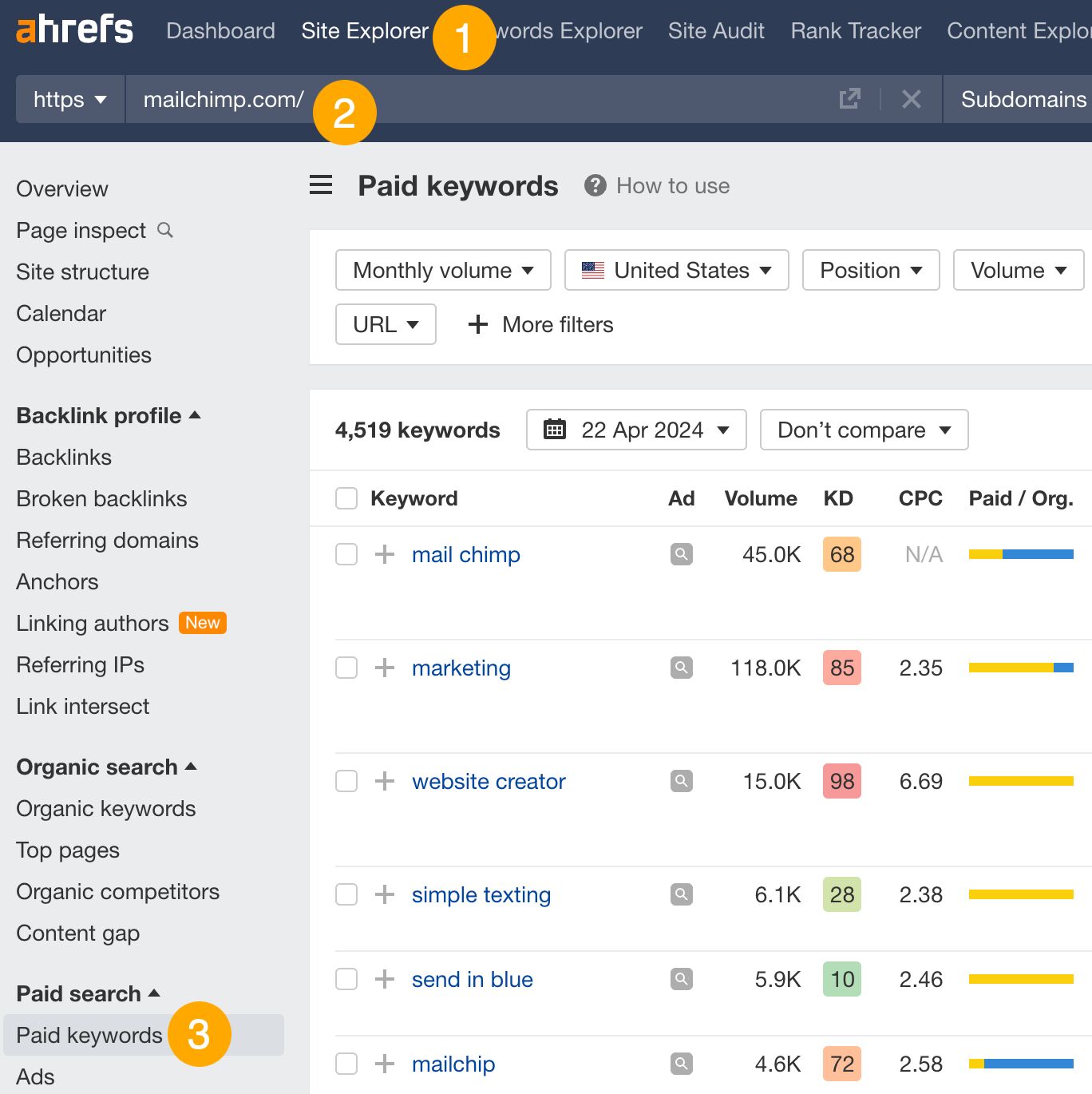

This report shows you the keywords your competitors are targeting via Google Ads.
Since your competitor is paying for traffic from these keywords, it may indicate that they’re profitable for them—and could be for you, too.
You know what keywords your competitors are ranking for or bidding on. But what do you do with them? There are basically three options.
1. Create pages to target these keywords
You can only rank for keywords if you have content about them. So, the most straightforward thing you can do for competitors’ keywords you want to rank for is to create pages to target them.
However, before you do this, it’s worth clustering your competitor’s keywords by Parent Topic. This will group keywords that mean the same or similar things so you can target them all with one page.
Here’s how to do that:
- Export your competitor’s keywords, either from the Organic Keywords or Content Gap report
- Paste them into Keywords Explorer
- Click the “Clusters by Parent Topic” tab
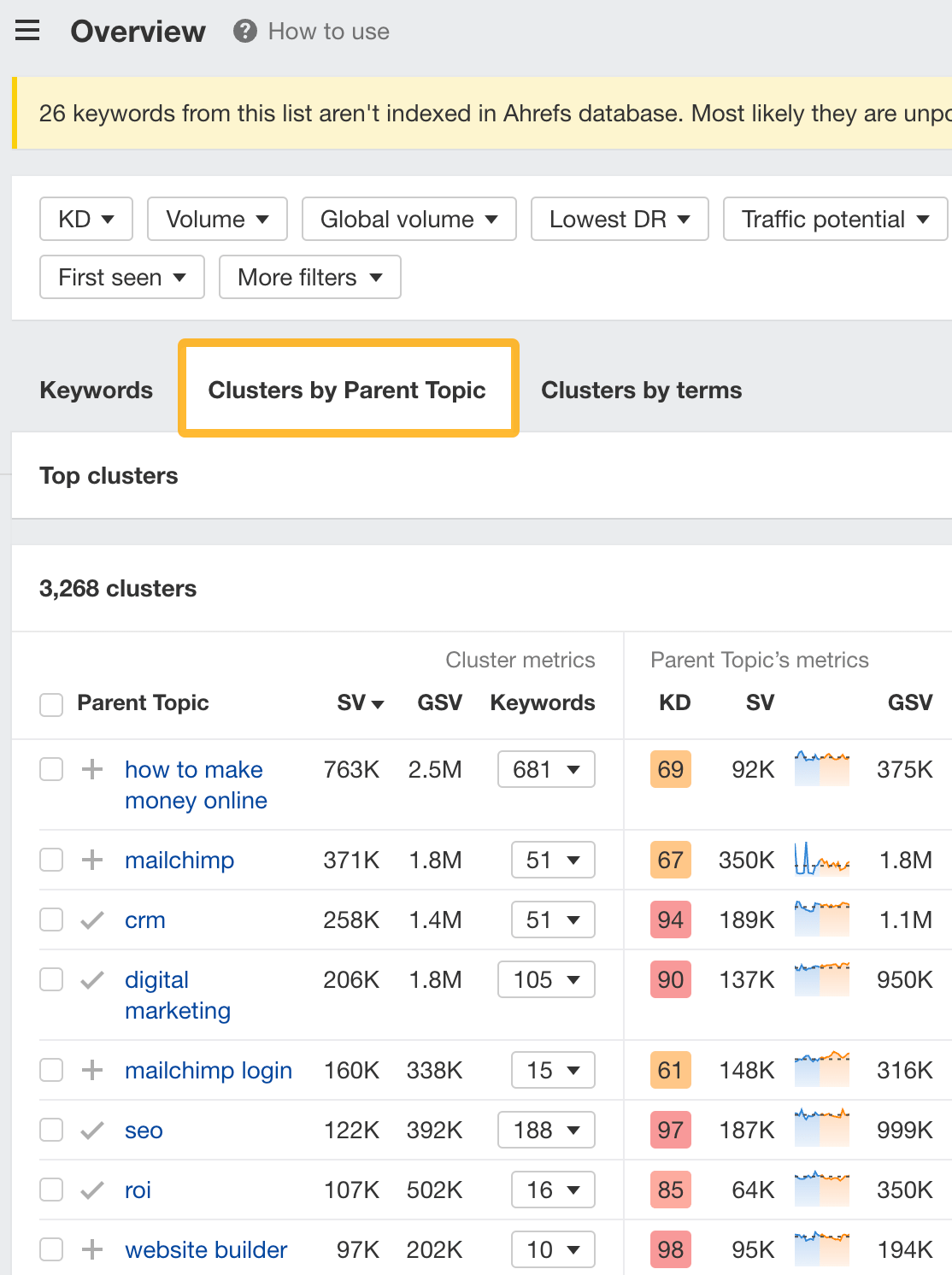

For example, MailChimp ranks for keywords like “what is digital marketing” and “digital marketing definition.” These and many others get clustered under the Parent Topic of “digital marketing” because people searching for them are all looking for the same thing: a definition of digital marketing. You only need to create one page to potentially rank for all these keywords.
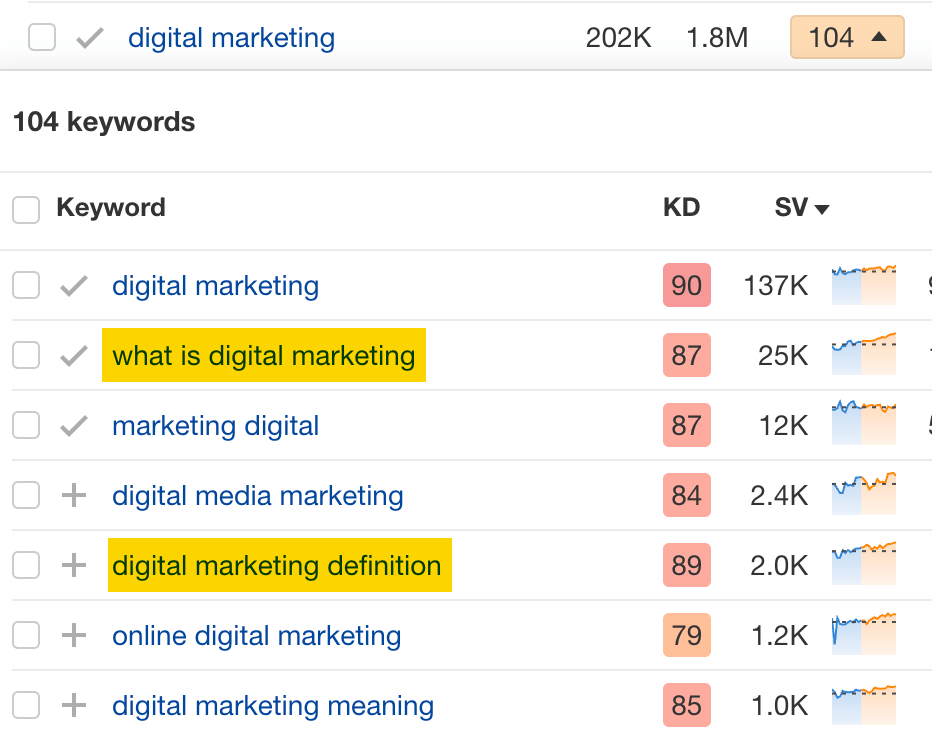

2. Optimize existing content by filling subtopics
You don’t always need to create new content to rank for competitors’ keywords. Sometimes, you can optimize the content you already have to rank for them.
How do you know which keywords you can do this for? Try this:
- Export your competitor’s keywords
- Paste them into Keywords Explorer
- Click the “Clusters by Parent Topic” tab
- Look for Parent Topics you already have content about
For example, if we analyze our competitor, we can see that seven keywords they rank for fall under the Parent Topic of “press release template.”


If we search our site, we see that we already have a page about this topic.


If we click the caret and check the keywords in the cluster, we see keywords like “press release example” and “press release format.”
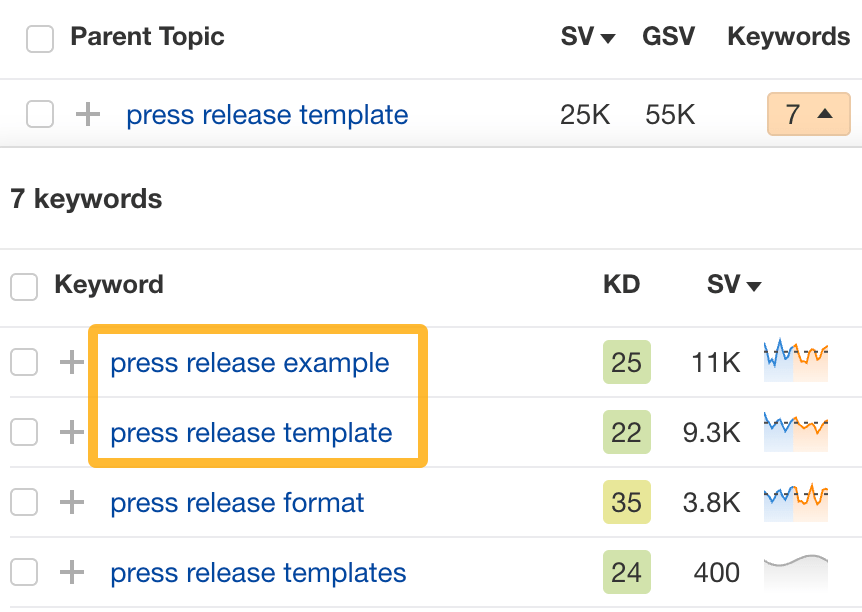

To rank for the keywords in the cluster, we can probably optimize the page we already have by adding sections about the subtopics of “press release examples” and “press release format.”
3. Target these keywords with Google Ads
Paid keywords are the simplest—look through the report and see if there are any relevant keywords you might want to target, too.
For example, Mailchimp is bidding for the keyword “how to create a newsletter.”


If you’re ConvertKit, you may also want to target this keyword since it’s relevant.
If you decide to target the same keyword via Google Ads, you can hover over the magnifying glass to see the ads your competitor is using.
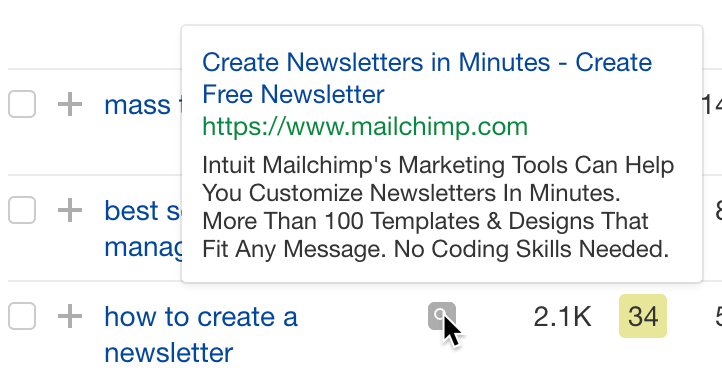

You can also see the landing page your competitor directs ad traffic to under the URL column.


Learn more
Check out more tutorials on how to do competitor keyword analysis:
SEO
Google Confirms Links Are Not That Important
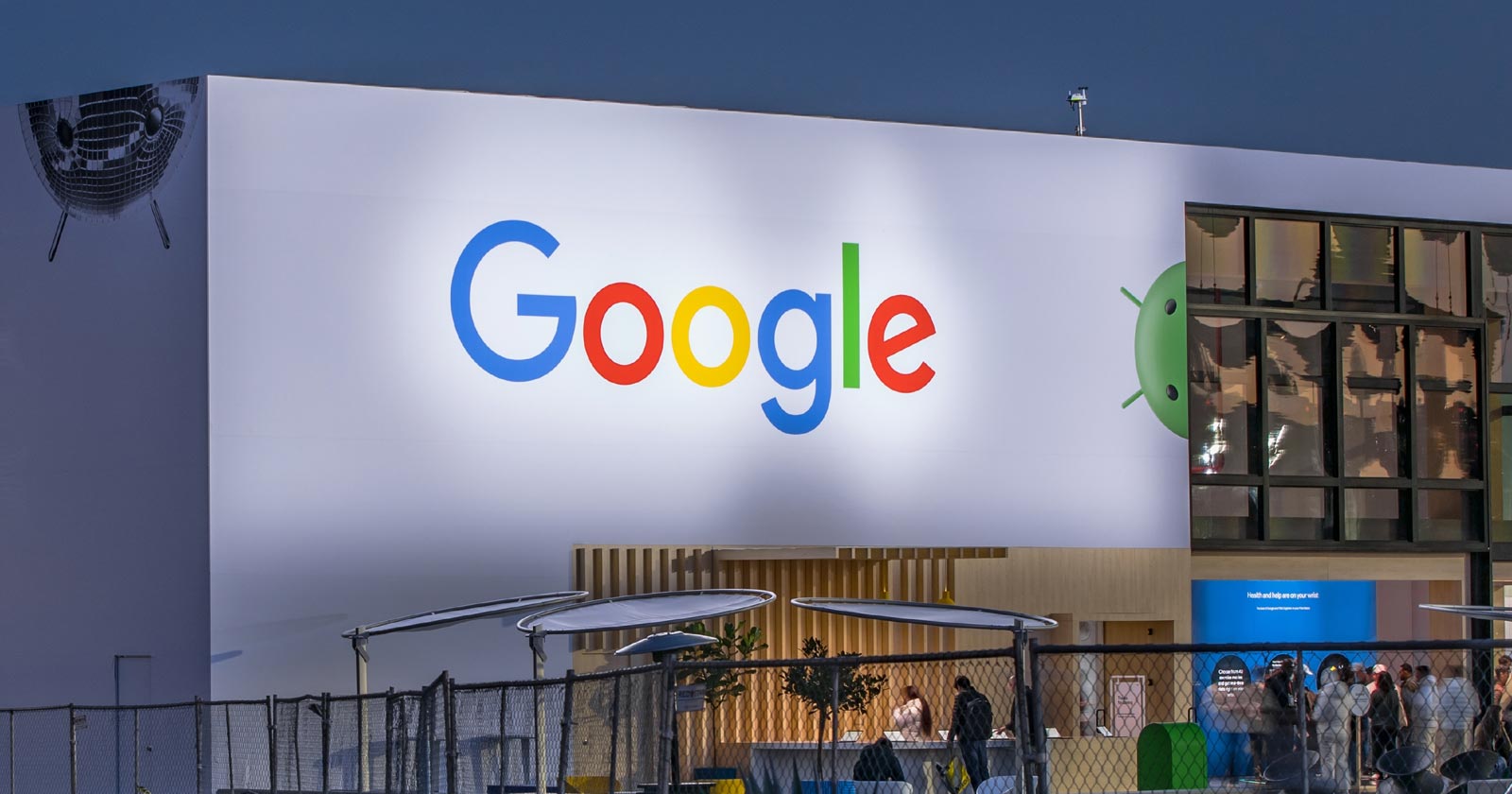
Google’s Gary Illyes confirmed at a recent search marketing conference that Google needs very few links, adding to the growing body of evidence that publishers need to focus on other factors. Gary tweeted confirmation that he indeed say those words.
Background Of Links For Ranking
Links were discovered in the late 1990’s to be a good signal for search engines to use for validating how authoritative a website is and then Google discovered soon after that anchor text could be used to provide semantic signals about what a webpage was about.
One of the most important research papers was Authoritative Sources in a Hyperlinked Environment by Jon M. Kleinberg, published around 1998 (link to research paper at the end of the article). The main discovery of this research paper is that there is too many web pages and there was no objective way to filter search results for quality in order to rank web pages for a subjective idea of relevance.
The author of the research paper discovered that links could be used as an objective filter for authoritativeness.
Kleinberg wrote:
“To provide effective search methods under these conditions, one needs a way to filter, from among a huge collection of relevant pages, a small set of the most “authoritative” or ‘definitive’ ones.”
This is the most influential research paper on links because it kick-started more research on ways to use links beyond as an authority metric but as a subjective metric for relevance.
Objective is something factual. Subjective is something that’s closer to an opinion. The founders of Google discovered how to use the subjective opinions of the Internet as a relevance metric for what to rank in the search results.
What Larry Page and Sergey Brin discovered and shared in their research paper (The Anatomy of a Large-Scale Hypertextual Web Search Engine – link at end of this article) was that it was possible to harness the power of anchor text to determine the subjective opinion of relevance from actual humans. It was essentially crowdsourcing the opinions of millions of website expressed through the link structure between each webpage.
What Did Gary Illyes Say About Links In 2024?
At a recent search conference in Bulgaria, Google’s Gary Illyes made a comment about how Google doesn’t really need that many links and how Google has made links less important.
Patrick Stox tweeted about what he heard at the search conference:
” ‘We need very few links to rank pages… Over the years we’ve made links less important.’ @methode #serpconf2024″
Google’s Gary Illyes tweeted a confirmation of that statement:
“I shouldn’t have said that… I definitely shouldn’t have said that”
Why Links Matter Less
The initial state of anchor text when Google first used links for ranking purposes was absolutely non-spammy, which is why it was so useful. Hyperlinks were primarily used as a way to send traffic from one website to another website.
But by 2004 or 2005 Google was using statistical analysis to detect manipulated links, then around 2004 “powered-by” links in website footers stopped passing anchor text value, and by 2006 links close to the words “advertising” stopped passing link value, links from directories stopped passing ranking value and by 2012 Google deployed a massive link algorithm called Penguin that destroyed the rankings of likely millions of websites, many of which were using guest posting.
The link signal eventually became so bad that Google decided in 2019 to selectively use nofollow links for ranking purposes. Google’s Gary Illyes confirmed that the change to nofollow was made because of the link signal.
Google Explicitly Confirms That Links Matter Less
In 2023 Google’s Gary Illyes shared at a PubCon Austin that links were not even in the top 3 of ranking factors. Then in March 2024, coinciding with the March 2024 Core Algorithm Update, Google updated their spam policies documentation to downplay the importance of links for ranking purposes.
The documentation previously said:
“Google uses links as an important factor in determining the relevancy of web pages.”
The update to the documentation that mentioned links was updated to remove the word important.
Links are not just listed as just another factor:
“Google uses links as a factor in determining the relevancy of web pages.”
At the beginning of April Google’s John Mueller advised that there are more useful SEO activities to engage on than links.
Mueller explained:
“There are more important things for websites nowadays, and over-focusing on links will often result in you wasting your time doing things that don’t make your website better overall”
Finally, Gary Illyes explicitly said that Google needs very few links to rank webpages and confirmed it.
I shouldn’t have said that… I definitely shouldn’t have said that
— Gary 鯨理/경리 Illyes (so official, trust me) (@methode) April 19, 2024
Why Google Doesn’t Need Links
The reason why Google doesn’t need many links is likely because of the extent of AI and natural language undertanding that Google uses in their algorithms. Google must be highly confident in its algorithm to be able to explicitly say that they don’t need it.
Way back when Google implemented the nofollow into the algorithm there were many link builders who sold comment spam links who continued to lie that comment spam still worked. As someone who started link building at the very beginning of modern SEO (I was the moderator of the link building forum at the #1 SEO forum of that time), I can say with confidence that links have stopped playing much of a role in rankings beginning several years ago, which is why I stopped about five or six years ago.
Read the research papers
Authoritative Sources in a Hyperlinked Environment – Jon M. Kleinberg (PDF)
The Anatomy of a Large-Scale Hypertextual Web Search Engine
Featured Image by Shutterstock/RYO Alexandre
-

 PPC5 days ago
PPC5 days ago19 Best SEO Tools in 2024 (For Every Use Case)
-

 MARKETING6 days ago
MARKETING6 days agoStreamlining Processes for Increased Efficiency and Results
-
SEARCHENGINES6 days ago
Daily Search Forum Recap: April 17, 2024
-

 SEO6 days ago
SEO6 days agoAn In-Depth Guide And Best Practices For Mobile SEO
-

 PPC6 days ago
PPC6 days ago97 Marvelous May Content Ideas for Blog Posts, Videos, & More
-
SEARCHENGINES5 days ago
Daily Search Forum Recap: April 18, 2024
-

 MARKETING6 days ago
MARKETING6 days agoEcommerce evolution: Blurring the lines between B2B and B2C
-
SEARCHENGINES4 days ago
Daily Search Forum Recap: April 19, 2024
















You must be logged in to post a comment Login